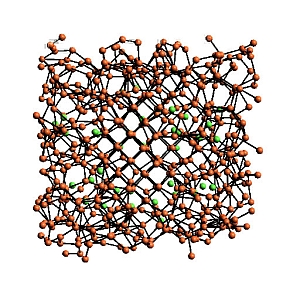Thanks to iconic actress Marilyn Monroe in the 1953 film classic 'Gentlemen Prefer Blondes', it's common knowledge that diamonds are a girl's best friend.
Diamonds are also ideally suited to other less glamorous but more valuable applications that rely on physical properties such as exceptional hardness and heat conductivity.
Synchrotron x-rays could hold the key to some exciting new high-tech diamond applications, providing unique analytical tools and production methods.
Polycrystalline diamond films composed of millions of tiny diamond crystals grown at relatively low temperatures (600-800 degrees C) and pressures (around 100 torr, or approximately 13 percent of atmospheric pressure).
Far more versatile than single crystals, microcrystalline and nano-crystalline diamond films can be deposited on silicon, steel and other surfaces. Applications include protective films for knife edges and other surfaces, electron emission devices, heat sinks for solid state lasers and possibly thermo-electric energy converters. Nano-diamonds can also act as photon sources for the high-tech quantum communication and cryptography devices currently being developed for secure, long-distance communications purposes.
 |
 |
|
Diamond model showing carbon atoms in a lattice |
Nano-diamond model showing carbon atoms in a deformed lattice (hydrogen atoms are green) |
Professor Alon Hoffman from Technion, the Israel Institute of Technology, has just spent six months at the University of Melbourne conducting research into the production and properties of nano-diamonds in collaboration with Professor Steven Prawer.
"We are attempting to harness the supreme properties of diamond for thermo-electric energy conversion and energy storage to help solve outstanding problems in the world today," Alon explained. "With this in mind, we are investigating the electron emission properties of diamond and high temperatures and the possibility of storing hydrogen in nano-diamond films."
Another objective is to create nano-diamond films that can act as single photon sources for quantum communication and cryptography. One approach involves selectively bonding nitrogen atoms to individual diamond nano-crystals, a task that requires synchrotron x-ray beams.
Similar challenges are associated with selectively bonding and removing hydrogen atoms and oxygen atoms from the diamond surface. In its natural state, diamond is electrically insulating, as are oxidised diamond surfaces. Hydrogenated diamond surfaces, on the other hand, are electrically conducting. This creates the potential to control and pattern the local electronic properties of the diamond surface using a finely focussed synchrotron x-ray beam by selectively promoting the removal of hydrogen atoms and making the diamond surface receptive to the adsorption of oxygen atoms.
During his stay in Melbourne, Alon made several visits to the Australian Synchrotron to investigate the thermal stability and surface properties of nano-diamond films. With the support of Bruce Cowie and the soft x-ray beamline team, Alon used a technique called 'near edge x-ray adsorption fine structure' (NEXAFS) to measure the presence of hydrogen on diamond surfaces and sub-surface regions. This involved measuring the adsorption cross-section of photons in the 280-310 eV energy range.
"We proved that NEXAFS is very sensitive to hydrogen bonding to diamond surfaces," Alon said. "This is a most important result as it allows us to determine the bonding of hydrogen to diamond surfaces.
"The soft x-ray beamline at the Australian Synchrotron gave us world-class NEXAFS spectra of diamond at ultra high resolution and took only a few minutes to produce results that required a week at a second-generation synchrotron in Europe," Alon said. "It offers a great combination of very high energy resolution, high spatial resolution and large intensity."
